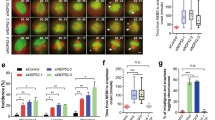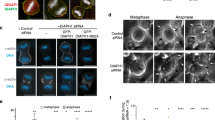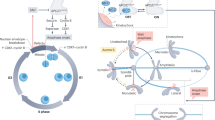Abstract
The accurate segregation of chromosomes at mitosis depends on a correctly assembled bipolar spindle that exerts balanced forces on each sister chromatid1,2. The integrity of mitotic chromosome segregation is ensured by the spindle assembly checkpoint (SAC) that delays mitosis in response to defective spindle organisation or failure of chromosome attachment2,3. Here we describe a distinct mitotic checkpoint in the fission yeast, Schizosaccharomyces pombe, that monitors the integrity of the actin cytoskeleton and delays sister chromatid separation, spindle elongation and cytokinesis until spindle poles have been properly oriented. This mitotic delay is imposed by a stress-activated mitogen-activated protein (MAP) kinase pathway but is independent of the anaphase-promoting complex (APC)4,5.
This is a preview of subscription content, access via your institution
Access options
Subscribe to this journal
Receive 51 print issues and online access
$199.00 per year
only $3.90 per issue
Buy this article
- Purchase on Springer Link
- Instant access to full article PDF
Prices may be subject to local taxes which are calculated during checkout




Similar content being viewed by others
References
Nicklas, R. B. How cells get the right chromosomes. Science 275, 632–637 (1997).
Amon, A. The spindle checkpoint. Curr. Opin. Genet. Dev. 9, 69–75 (1999).
Hardwick, K. G. et al. Lesions in many different spindle components activate the spindle checkpoint in the budding yeast Saccharomyces cerevisiae. Genetics 152, 509–518 (1999).
Zachariae, W. & Nasmyth, K. Whose end is destruction: cell division and the anaphase-promoting complex. Genes Dev. 13, 2039–2058 (1999).
Yanagida, M. et al. Control of metaphase-anaphase progression by proteolysis: cyclosome function regulated by the protein kinase A pathway, ubiquitination and localization. Phil. Trans. R. Soc. Lond. B 354, 1559–1569 (1999).
Marks, J. M. & Hyams, J. S. Localisation of F actin through the cell division cycle of Schizosaccharomyces pombe. Eur. J. Cell Biol. 39, 27–32 (1985).
Spector, I., Shochet, N. R., Kashman, Y. & Groweiss, A. Latrunculins: novel marine toxins that disrupt microfilament organization in cultured cells. Science 219, 493–495 (1983).
Hagan, I. M. & Hyams, J. S. Forces acting on the fission yeast anaphase spindle. Cell. Motil. Cytoskeleton 34, 69–75 (1996).
Mallavarapu, A., Sawin, K. & Mitchison, T. A switch in microtubule dynamics at the onset of anaphase B in the mitotic spindle of Schizosaccharomyces pombe. Curr. Biol. 9, 1423–1426 (1999).
Nabeshima, K. et al. Dynamics of centromeres during metaphase-anaphase transition in fission yeast: Dis1 is implicated in force balance in metaphase bipolar spindle. Mol. Biol. Cell 9, 3211–3225 (1998).
Ishiguro, J. & Kobayashi, W. An actin point-mutation neighboring the ‘hydrophobic plug’ causes defects in the maintenance of cell polarity and septum organization in the fission yeast Schizosaccharomyces pombe. FEBS Lett. 392, 237–241 (1996).
Birkenbihl, R. P. & Subramani, S. The rad21 gene product of Schizosaccharomyces pombe is a nuclear, cell cycle-regulated phosphoprotein. J. Biol. Chem. 270, 7703–7711 (1995).
Tomonaga, T. et al. Characterization of fission yeast cohesin: essential anaphase proteolysis of Rad21 phosphorylated in the S phase. Genes Dev. 14, 2757–2770 (2000).
Chen, R. H., Waters, J. C., Salmon, E. D. & Murray, A. W. Association of spindle assembly checkpoint component XMAD2 with unattached kinetochores. Science 274, 242–246 (1996).
He, X., Patterson, T. E. & Sazer, S. The Schizosaccharomyces pombe spindle checkpoint protein Mad2p blocks anaphase and genetically interacts with the anaphase-promoting complex. Proc. Natl Acad. Sci. USA 94, 7965–7970 (1997).
Funabiki, H. et al. Cut2 proteolysis required for sister-chromatid separation in fission yeast. Nature 381, 438–441 (1996).
Uhlmann, F. et al. Cleavage of cohesin by the CD clan protease separin triggers anaphase in yeast. Cell 103, 375–386 (2000).
Moreno, S., Hayles, J. & Nurse, P. Regulation of p34cdc2 protein kinase during mitosis. Cell 58, 361–372 (1989).
Alfa, C. E., Ducommun, B., Beach, D. & Hyams, J. S. Distinct nuclear and spindle pole body population of cyclin-cdc2 in fission yeast. Nature 347, 680–682 (1990).
Shiozaki, K. & Russell, P. Conjugation, meiosis, and the osmotic stress response are regulated by Spc1 kinase through Atf1 transcription factor in fission yeast. Genes Dev. 10, 2276–2288 (1996).
Wilkinson, M. G. et al. The Atf1 transcription factor is a target for the Sty1 stress activated MAP kinase pathway in fission yeast. Genes Dev. 10, 2289–2301 (1996).
Millar, J. B. A., Buck, V. & Wilkinson, M. G. Pyp1 and Pyp2 PTPases dephosphorylate an osmosensing MAP kinase controlling cell size at division in fission yeast. Genes Dev. 9, 2117–2130 (1995).
Shiozaki, K. & Russell, P. Cell cycle control linked to extracellular environment by MAP kinase pathway in fission yeast. Nature 378, 739–743 (1995).
Ohkura, H., Hagan, I. M. & Glover, D. M. The conserved Schizosaccharomyces pombe kinase plo1, required to form a bipolar spindle, the actin ring, and septum, can drive septum formation in G1 and G2 cells. Genes Dev. 9, 1059–1073 (1995).
Tanaka, K. et al. The role of Plo1 kinase in mitotic commitment and septation in Schizosaccharomyces pombe. EMBO J. 20, 1259–1270 (2001).
Knoblich, J. A. Mechanisms of asymmetric cell division during animal development. Curr. Opin. Cell Biol. 9, 833–841 (1997).
Lu, B., Jan, L. Y. & Jan, Y. N. Asymmetric cell division: lessons from flies and worms. Curr. Opin. Genet. Dev. 8, 392–399 (1998).
Yamashita, M., Yoshikuni, M., Hirai, T., Fukada, S. & Nagahama, Y. A monoclonal antibody against the PSTAIR sequence of p34cdc2 catalytic subunit of maturation-promoting factor and key regulator of the cell cycle. Dev. Growth Differ. 33, 617–624 (1991).
Acknowledgements
We thank V. Amin and K. Adams for technical assistance; F. Uhlmann and K. Nasmyth for communicating results before publication; and T. Matsumoto, S. Subramani and M. Yanagida for strains and reagents. We also thank V. Buck, L. Johnston, S. Jensen and D. Mulhivill for comments and critical reading of the manuscript, and members of the Hyams and Millar laboratories for their encouragement and support. This work was supported by a Wellcome Trust grant to J.S.H. and by a MRC grant to J.B.A.M.
Author information
Authors and Affiliations
Corresponding author
Rights and permissions
About this article
Cite this article
Gachet, Y., Tournier, S., Millar, J. et al. A MAP kinase-dependent actin checkpoint ensures proper spindle orientation in fission yeast. Nature 412, 352–355 (2001). https://doi.org/10.1038/35085604
Received:
Accepted:
Issue Date:
DOI: https://doi.org/10.1038/35085604
This article is cited by
-
Disruption of actin dynamics induces autophagy of the eukaryotic chaperonin TRiC/CCT
Cell Death Discovery (2022)
-
The Cardiac Sarcomere and Cell Cycle
Current Cardiology Reports (2022)
-
CO2 enhances the formation, nutrient scavenging and drug resistance properties of C. albicans biofilms
npj Biofilms and Microbiomes (2021)
-
STK16 regulates actin dynamics to control Golgi organization and cell cycle
Scientific Reports (2017)
-
Dynamics and functions of the actin cytoskeleton during the plant cell cycle
Chinese Science Bulletin (2011)
Comments
By submitting a comment you agree to abide by our Terms and Community Guidelines. If you find something abusive or that does not comply with our terms or guidelines please flag it as inappropriate.



